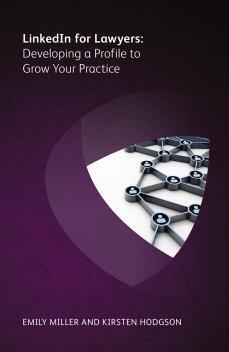Can LinkedIn help lawyers improve their practice in an efficient and cost effective way, or is it a time-consuming luxury? Barry Wilkinson reviews LinkedIn for Lawyers - Developing a Profile to Grow Your Practice (by Emily Miller and Kirsten Hodgson) and offers his verdict
The authors of this book, LinkedIn for Lawyers - Developing a Profile to Grow Your Practice, note at the outset there are now over 380 million users of LinkedIn around the world, and growing by thousands per day, so it cannot be ignored. LinkedIn is part of the wider debate about professional services marketing, which often defaults to personality-based preferences. Some lawyers like ‘marketing’ and so take readily to LinkedIn. Others hate the mere thought of having to sell themselves and meeting lots of people they do not know, and for some in this group, LinkedIn has been portrayed as a less demanding, softer option – a way of marketing yourself without having to endure the agonies of face-to-face networking or, even worse, delivering talks to an audience. The authors dispel that notion quickly. LinkedIn is an alternative to face to face contact, but it is not a soft option.

The American consultancy Hinge have researched the subject and they say that: ‘In professional services marketing, it’s likely that many of your clients discovered your firm through face-to-face networking. The importance of networking has not gone away. However, as digital marketing has outgrown traditional marketing in certain ways, social media platforms (such as LinkedIn) have revolutionized networking by providing online venues for building relationships and demonstrating thought leadership.’
The authors build on this premise to explain that whilst LinkedIn provides opportunities to reach far more people online that we ever could in face-to-face meetings – not only potential clients, but also other professionals who can introduce us to their clients – those people can only form their views of us through what they learn from us online. Hence it is doubly important to manage our online presence well. Or as the authors put it: “Having no LinkedIn account is better than having one that makes you look unprofessional, unconnected or disinterested!”.
The first half of the book is devoted to the creation of your LinkedIn profile. It assumes absolutely no knowledge, and some of the detailed step-by-step, click-by-click instructions are a godsend to the digital illiterate. This book makes it very easy to get started and to become competent and widely ‘Linked’ very quickly. For those whose practice is primarily based on personal contact and local reputation, the guide to creating a profile and chapters covering recommendations and endorsements can provide a rapid and worthwhile payback in themselves.
One of the real eye-openers to me was the impact that seemingly small changes to the profile can have on the reader’s perception. This marks the authors out as genuine specialists and I shall certainly be acting on some of their suggestions.
But LinkedIn offers wider opportunities – particularly to those whose reputation is built on a niche specialism, whether technical expertise or industry specialism. So the authors include chapters to help enhance your profile as a thought leader by adding supporting material – from white papers and pdf publications through to slide presentations – which can be delivered through LinkedIn publishing and their associated website SlideShare (itself one of the most viewed websites).
To achieve maximum impact in minimum time, the simple summary of bullet point actions at the end of each chapter are useful, as are the ‘DO NOT’ warnings, to help you avoid accidentally triggering unintended consequences, which can be so easy with software.
Regular use of case studies help to bring the instructions to life, and there is a whole chapter of case studies at the end which usefully illustrates how different lawyers have created customised and personalised profiles to emphasise their own strengths – all from the same basic framework.
My own recent experiences have led me to believe that LinkedIn is like other areas of technology (hardware and software) in that there are several levels of results achievable. For some people it can fine-tuned endlessly to become their primary marketing weapon and take the place of most other marketing activity. But these will be the minority. For the rest we should take heart from Pareto’s rule – 80% of the results can probably be achieved with 20% of the effort.
This book provides a useful service, even if those who are looking for a soft option will be disappointed. The authors do demonstrate that it is not hard to become proficient and benefit from LinkedIn, but it does require some discipline and persistence.
As to whether it is worth the effort, and whether social networking will ever displace face-to-face networking in the UK legal market, the Hinge study mentioned above said of their research on 1,028 professional services buyers in the USA in 2014 that six in ten turned to social media to check out firms before they purchase and that social media presence is now even more critical than client references.
So assuming that we will not be too far behind the Americans, whilst the authors are probably right to say that no profile is better than a slipshod one, maybe we should at least take heed of the first part of this book and create that profile carefully.





















